
Do Piercing Guns Suck? BME REVIEWS THE STUDEX SYSTEM 75™
|
"A tool is but the extension of a man's hand, and a machine is but a complex tool. And he that invents a machine augments the power of a man and the well-being of mankind"
– Henry Ward Beecher
As you probably know, BME doesn’t generally cover piercing guns. It’s not because of safety issues (see BME/Risks) – BME discusses many activities that are equally or even more dangerous and ill-advised. It’s a cultural issue. Piercing gun “culture”, if you can call it that, is distinct from BME’s focus on atypical body modification and is not particularly relevant to our core mission. However, piercing gun manufacturers like Studex are slowly starting to create tools that are capable of untrained piercing of not just ears and noses, but many other body parts as well. When navel piercing guns start being used at mall kiosks, how will piercers in fully equipped studios be affected?
Earlier designs of piercing guns were simple spring-loaded devices into which an ear piercing stud and backing could be loaded, held around the ear lobe, and then fired through.
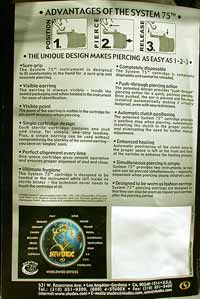 “Piercing as easy as 1-2-3” …or so the brochure claims. |
Not only was the system physically inadequate for anything but basic ear piercing, but the plastic gun was effectively impossible to keep sterile or even clean properly, and the system was linked to the spread of hepatitis and other diseases, as well as damage to cartilage resulting in infection and collapse of the ear’s structure. While these apparently primitive and destructive systems are still a dominant force in the industry, recently a number of companies have released “cartridge based” piercing systems which attempt to address the majority of these problems.
Cartridge based systems improve on the spring-loaded guns in two main ways. First, they tend to use a “pusher” system which forces the piercing stud through the tissue by squeezing a handle which drives the stud, rather than aggressively firing it with spring action. In theory this causes less trauma to the tissue (no more shattered cartilage), as well as reducing the potential for blood spray which could contaminate the gun. Second, the cartridge which contains the stud as well as some of the gun’s mechanism is disposable, immensely reducing the potential for transfer of microbes from client to client even if the mechanism is exposed to the client’s fluids.
Rachel and I were able to meet with Ken Gardner, Studex’s Canadian distributor, who was kind enough to offer us their latest product for review – the “System 75(TM)”. While he did later characterize us as”tattooed from asshole to head” and with “ears big enough to put a tennis ball through”, he was likable and helpful, defended us against their main branch’s fears, and we walked away with a bag full of product for review as well as some literature on the devices.
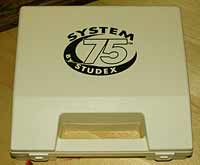
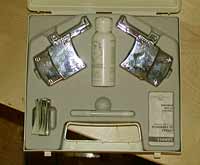
A two gun System (TM) kit from Studex including a marking pen,
cleaning solution and wipes, two plastic guns, and a sample cartridge.
I was surprised Ken was so helpful – Studex’s reputation is far less friendly, largely due to lawyer Fred Safford’s notoriety for threatening anyone involved in body piercing who speaks out negatively against piercing guns. Even though medical journals have documented and published numerous articles showing everything from Hepatitis transferred by ear piercing studs, to physical damage to the ear, it can be very difficult to speak publicly about these surprisingly common problems – many professionals inside the industry urged me not to write this article for fear of BME being hit with a nuisance suit. In any case, Ken assured me that these problems had not only been addressed in the new System 75™ design, but that according to Fred, the doctors had universally recanted their claims about even the older style guns (which Studex continues to market today). Ken didn’t have the information on these studies, but Fred offered to send me information about these doctors’ retractions. Below is the entirety of the letter which I received from Fred:
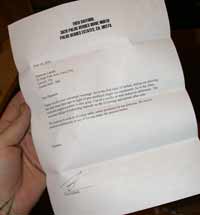
This wasn’t particularly convincing (and implied the risk remained in the older style guns they continued to market alongside the System 75), so I did a few searches through MEDLINE and other services. Hundreds of articles discussing the risks of piercing guns and warnings to avoid them were returned, and I wasn’t able to find a single one describing either benefits over studio piercing or mentioning a retraction of previous claims. A great many focused on dermatitis and metal allergies due to the apparently low grade of materials used in some of the jewelry, but many others were directly related to complications due to the design of the gun or the stud itself.
Complications included marked increases of hepatitis infections among people with piercings done with a piercing gun, several with apparent direct links (where they were able to pinpoint the point of infection directly, rather than circumstantially), as well as problems such as embedded earrings, viremia and liver disease resulting from infections contracted from piercing guns, pseudomonas aeruginosa and other acute psudomonas chrondritis secondary to ear piercing, ear deformity, pseudolymphoma, sarcoidal tissue reactions, auricular chondritis, toxic shock syndrome, perichondrial abscesses, post-streptococcal glomerulonephritis, cytotoxicity due to corrosion of the jewelry, and a wide variety of other complications. I was able to find studies from the 1970′s up until today, and during most of that period, no significant changes were made by the ear piercing industry to correct the problem. However, now that piercing studios have significantly threatened their market dominance, they’ve finally been forced to respond – apparently not for ethical reasons or because of caring about their customers, but for survival. Thus the System 75™ from Studex and other analogous products from other companies such as Inverness have hit the market. However, even knowing these risks (and presumably acknowledging them by addressing them with the new designs), they have not taken earlier designs off the market.
In all fairness, it must be noted that a great deal of care has gone into the design of the System 75™, which really does represent an enormous leap over the older guns (which the above mentioned studies primarily refer to) which were easier to link to serious health problems.
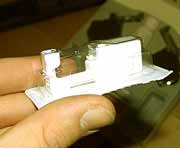
The cartridges come in sealed sterile packaging, which can presumably be handled freely without putting the contents at risk.
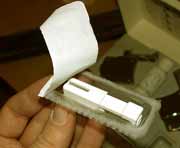
Opening the package does not involve touching the cartridge or jewelry, which is at the opposite end of the package from the part that is peeled off.
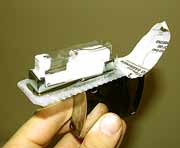
The cartridge is then picked up using the gun. The part that is exposed when the packaging is peeled open is the part that interfaces with the gun, so the easiest way to use the unit is also the safest.
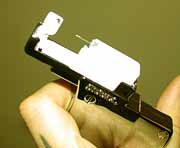
The packaging is then discarded, leaving the jewelry exposed. Unlike some of the other systems on the market, it is very easy to see where the jewelry point is and the system is simple to co-ordinate and line up with one’s marks.
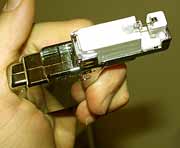
The trigger is depressed, pushing the jewelry through the tissue and latching the stud into its backing. The gun’s design does not allow crushing the tissue, and different length studs are available for different sized lobes. When the trigger is released, the part of the cartridge that held the stud opens like a flower and releases the jewelry.
After piercing, every part of the gun that came in contact with the client – the cartridge – is discarded. Unlike a spring loaded system which is almost entirely reused between clients, the perfect-world potential for contamination using the System 75(TM) as directed is extremely minimal. Even if the pusher unit itself became contaminated – which to me seems inevitable – the odds of transferring that contamination between clients seems very, very low. A large number of designs of jewelry are available in these sterile packs, so there should be no need to switch the jewelry after piercing as was sometimes done in the past.
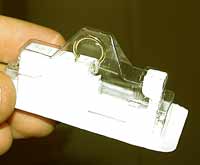
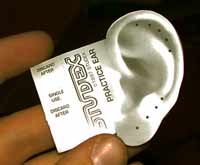
Above right you can see the child-sized “practice ear” with recommended placements. In the past, upper ear placements were strongly frowned upon due to the damage that could be done to cartilage by forcibly firing a dull stud through it, but the slow-push method in the new systems is thought to address this. In order to try it out we had a little “piercing gun party” and added studs to myself and a number of friends. Ear placements were simple and largely uneventful.
The only problem we had is that the cartridge’s release system (the part that’s supposed to open up and let go of the jewelry after the piercing) failed on a few of our test piercings, resulting in us needing to use our hands to physically force it open to release – which of course instantly eliminated most of the benefits of the new system and put both the operator and the client at unnecessary risk. A number of the cartridges actually fell apart entirely as we were using them. Because of this it seems important that anyone using this gun wear gloves in case they need to handle the jewelry or tissue directly.
The interesting thing about the System 75(TM) though, and the real reason I’m reviewing it, is that it’s designed to bridge gun technology into much more than just ear or nose piercing – it’s designed to be able to pierce nipples, navels, eyebrows, and more. When I talked to Studex, this was not yet approved in the US or in most of Canada, but Ken told me that in Quebec, parts of Europe, and most of all Japan, the gun was being used for full-on body piercing. Even the US-distributed catalog, which is primarily ear oriented, shows jewelry that while labeled as being for “ear piercing” appears to be more appropriate for body piercing due to its length and gauge (although some of it is tagged as being “Europe only”).
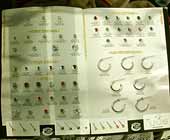
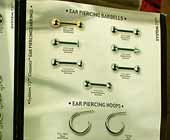
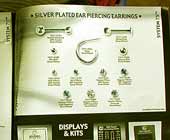
Ken was able to provide us with a number of the Japanese developed body piercing cartridges. They appeared to be 14 gauge, and came as both straight and curved barbells. The basic idea was the same as the ear piercing studs, although much more physical contact was needed to use them. The cartridge sits on its side in the packaging, requiring one to take it out by hand, rather than handling it exclusively with the pusher. In addition, after forcing the stud through the tissue being pierced, the bead has to be screwed on. Many of the benefits of the System 75(TM) were lost.
This is one of the body piercing gun barbells.As you can see, it is not very sharp, and contains a very steep bevel, making piercing both painful and difficult. This is additionally complicated by external threading which tears up the piercing as it passes through the freshly made hole.
Still, we attempted several piercings using this system. The first and somewhat bizarre problem we discovered, on our navel piercing attempt, was that the curved barbell was facing out in a concave fashion. This meant that it was being held in the exact opposite way required to do this or any other piercing, and was extremely difficult to coordinate – but BME photographer and guinea pig Phil Barbosa bravely allowed us to attempt it anyway. Using all of her strength, Rachel forced the stud into his belly as he grimaced in pain. The dull point managed to penetrate the first layer of skin, and then eventually ground to a halt as the external threading tore up Phil’s navel and wouldn’t allow us to get it all the way through no matter how hard any of us squeezed the unit’s handle, which eventually fell apart in protest. Extracting the stud wasn’t very fun either, as we had to pull the threading back through the fresh injury.
Every cartridge we used for body piercing disintegrated during use, and while the rate of failure was much lower when we used the smaller gauge ear studs, it was still unacceptably high. Also in this photo are one of the standard ear piercing studs with a butterfly backing, as well as a barbell bead, and a nostril piercing stud (about 14ga, but flaring out to 12ga to hold it in place).
We did a second test piercing on Badur through his hand web. It took an incredible amount of force to drive the stud through – probably about the same as it would take to drive a nail into soft wood using only your hand, was excessively painful, and the unit failed to release the stud, causing it to be partially pulled back into the wound and forcing us to dismantle the unit by hand to abort the piercing. People stopped volunteering so we tried piercing pieces of cloth, which also broke the cartridges. Finally we tried simply piercing the air, and continued to have the same failures. While it might be possible to modify it, I do not believe that this element of the System 75(TM) is a mature product yet, and I am somewhat disturbed that there are people using it on unsuspecting clients.
Even if the issue of the cartridges falling apart can be addressed or somehow explained away as a freak batch, I’m not convinced that performing commercial body piercings (rather than small gauge ear piercings) is a viable option with this design. It might be possible to build a unit that used a cutting bevel to place the jewelry, but even with that fix, it would be difficult to address the contamination issues in a way that made them sufficiently “idiot-proof” to be used by largely untrained staff. In addition, once the design reaches this level of complexity, it seems to me that it would be less complicated – and far less expensive – to simply use a traditional piercing studio.
In terms of ear piercing, if the System 75(TM) had not fallen apart so consistently in my testing I’d actually be giving it a thumbs up – in theory it is a well designed unit that really does address nearly every one of the physical problems that existed with earlier spring-loaded ear piercing systems. However, at least the units that I was given to test were not reliable and forced us to use our hands directly in enough cases to offset these corrections. If Studex is able to fix the release system then this is a safe unit for small gauge ear piercing, including cartilage piercing, in my opinion, although one must consider that the people using the guns are relatively untrained, have minimal access to contamination control devices and chemicals, and the possibility for misuse resulting in injury is very real. Studex also sells a smaller system of a similar design for single-use home piercing – the Medisept(TM) – and of the guns they make I’d select that one over the others.
In conclusion, Studex’s System 75(TM) does make significant improvements over traditional piercing gun systems, although I find it distasteful that these systems do not appear to have been developed until recently (and still have not been made exclusive), given that the problems have been documented and understood since at least the seventies. Additionally, given the failure rates we experienced, I can not in good conscience recommend them, especially since piercing studios equipped with contamination control knowledge and supplies – and autoclaves – offer ear piercing services within a few dollars of the same price. That said, if you’re going to get pierced with a gun and you don’t want to do it yourself, this is the right system to choose and offers immense advantages over a primitive spring loaded non-cartridge system. Finally, piercers have nothing to worry about in terms of the navel or nipple market being captured by this device or a similar one, as it is neither safe nor functional for general body piercing at this point, at least in our testing.

Shannon Larratt
BME.com
System 75, Medisept, and Studex are trademarks of STUDEX, Inc.
Thank you to Bagatelle Marketing for providing product samples and information.
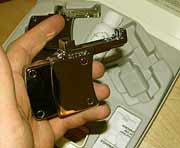
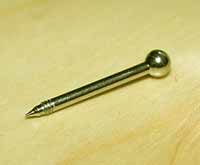
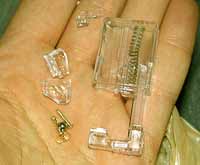
 BME/News and Modblog highlight only a small fraction of what
BME/News and Modblog highlight only a small fraction of what
babaloo think gun bad
babaloo think gun bad
babaloo think gun bad
I’ve used this article and another one posted by you to show multiple friends why using guns for piercing is such a dangerous idea.
Thanks for your work, Shannon!!
I’ve used this article and another one posted by you to show multiple friends why using guns for piercing is such a dangerous idea.
Thanks for your work, Shannon!!
I’ve used this article and another one posted by you to show multiple friends why using guns for piercing is such a dangerous idea.
Thanks for your work, Shannon!!
I was pierced in my belly button with the STUDEX gun for an instructional video in Redondo Beah California at 700 n. pch suite 300
redondo beach, ca 90277, a spa, and it went very wrong. The cartridge did not disengage correctly and the entire instrument was stuck on my body. Fred Safford , the one who is responsible for the production & legalities on this devie actually came at me with a pair of pliers to try to “ply” the piercing out of my skin. They actually have the entire event on video. This was so terrifying and the other part of the staff contined to use tweezers & a screwdriver to get the piercing loose. My belly button was infected immediately and I contacted the owners asap, but they have put me off for over 6 months & I have thousands of dollars in doctor bills & mutalation to my body. I am a dancer & model so this has greatly affected my work. I will make sure I do what it takes to stop anything like this from every happening again & I will continue to get restitution.
I was pierced in my belly button with the STUDEX gun for an instructional video in Redondo Beah California at 700 n. pch suite 300
redondo beach, ca 90277, a spa, and it went very wrong. The cartridge did not disengage correctly and the entire instrument was stuck on my body. Fred Safford , the one who is responsible for the production & legalities on this devie actually came at me with a pair of pliers to try to “ply” the piercing out of my skin. They actually have the entire event on video. This was so terrifying and the other part of the staff contined to use tweezers & a screwdriver to get the piercing loose. My belly button was infected immediately and I contacted the owners asap, but they have put me off for over 6 months & I have thousands of dollars in doctor bills & mutalation to my body. I am a dancer & model so this has greatly affected my work. I will make sure I do what it takes to stop anything like this from every happening again & I will continue to get restitution.
I was pierced in my belly button with the STUDEX gun for an instructional video in Redondo Beah California at 700 n. pch suite 300
redondo beach, ca 90277, a spa, and it went very wrong. The cartridge did not disengage correctly and the entire instrument was stuck on my body. Fred Safford , the one who is responsible for the production & legalities on this devie actually came at me with a pair of pliers to try to “ply” the piercing out of my skin. They actually have the entire event on video. This was so terrifying and the other part of the staff contined to use tweezers & a screwdriver to get the piercing loose. My belly button was infected immediately and I contacted the owners asap, but they have put me off for over 6 months & I have thousands of dollars in doctor bills & mutalation to my body. I am a dancer & model so this has greatly affected my work. I will make sure I do what it takes to stop anything like this from every happening again & I will continue to get restitution.